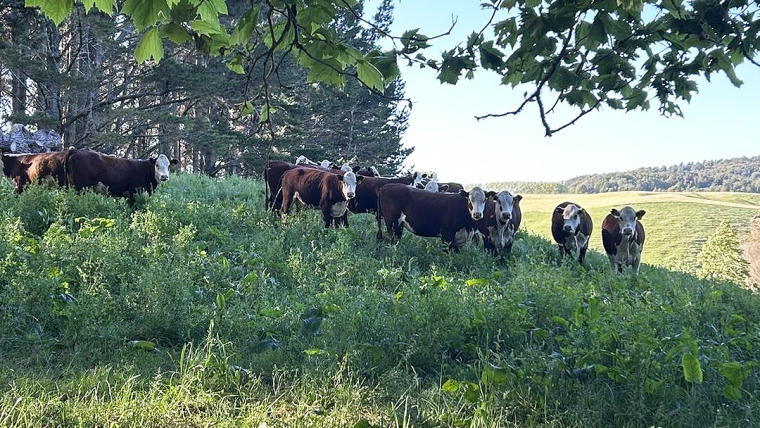
In 2023, Foodstuffs reported a $55 million profit, while Silver Fern Farms, one of New Zealand’s largest meat processors, posted a $22 million loss. The disparity in these figures underscores the challenges facing different sectors of the country's food and fibre industry. Sheep and beef farmers are particularly feeling the strain, with profits this year expected to be significantly lower due to softer lamb and wool prices. This leaves many farmers asking the question: what can be done?
For many, the options seem limited. Following the traditional route—supplying meat to major processors—offers little flexibility or control over pricing and market trends. But not all farmers are sticking to the well-trodden path. Some, like Tom Andrews, have chosen to buck the trend, finding innovative ways to diversify their operations. By selling meat directly to consumers, these farmers are not only carving out a niche in the local market but also taking greater control over their financial and environmental sustainability.
I recently caught up with Tom, a farmer and butcher based south-east of Cambridge. His operation is a good example of how farmers can adapt to the changing economic landscape, all while remaining true to the core values of sustainability and localism.
When asked to describe his farm, Tom painted a vivid picture of his life in the hills. “We’re about 20 kilometres southeast of Cambridge, a good farming area, right up in the hills. It’s all rolling and hill country,” he shared. It’s in this landscape that Tom raises sheep and beef, but what sets him apart from many other farmers in the region is his direct-to-consumer business model.
Tom’s journey into butchery began about 15 years ago when he realised that the traditional model of sending livestock to the works wasn’t cutting it for him or his family. “We had four young kids, and we weren’t really making ends meet,” he recalled. Despite working hard to fatten up his sheep and lambs, the financial returns were meagre, and the family struggled to make progress. Meanwhile, friends who enjoyed their home-cooked meals urged them to explore other avenues. “Friends were coming around, loving what we were cooking on the BBQ, and they started saying, ‘Do something about it.’ So I started thinking.”
What followed was a decision that would change the course of his farming business. Tom decided to have some of his meat processed through a small local abattoir in Ruakura and began selling it at the Cambridge farmers market. “We built a trailer, got a little chiller going, processed some meat, and went down to the market,” Tom explained. But the leap into retail wasn’t easy. “I was freaking out. I’m not used to talking to people and selling to the public.” Despite the nerves, his products were a hit, and repeat customers began to return week after week. “From that point on, we just sort of slowly grew.”
For Tom and his family, the decision to sell directly to consumers was less about a carefully planned business strategy and more about following their instincts. “It was sort of a leap of faith,” he admitted. “We didn’t really know what we were doing. Things just unfolded for us.” Navigating the legal requirements of setting up a meat-selling business wasn’t easy either. “It was hard to get all the correct paperwork from the council, but we just kept ticking away at the boxes.”
The early success at the farmers market gave Tom and his family the confidence to push further. Today, their operation has grown significantly from those early days. They now have their own micro-abattoir, giving them full control of the process, from fattening and slaughtering to butchering and retail. “We’re pretty much a fully closed loop now,” Tom said proudly. “We fatten the animals, kill them, process the meat, and sell it. All the stuff that comes out, we compost it, so we’ve got no fertiliser bills.”
The benefits of this closed-loop system go beyond just financial savings. For Tom, it represents a more sustainable way of farming. By keeping everything on the farm, he’s able to minimise waste and reduce his reliance on external inputs. “It’s been amazing how things have grown,” he said. “As you get into things, other opportunities appear, and it becomes quite insular in a way. We know exactly where we’re at each week and each year.”
One of the key advantages of Tom’s direct-to-consumer model is the higher returns at the farm gate. By cutting out the middlemen, he’s able to capture more value for his products. However, he is quick to point out that this doesn’t mean the work is any easier. “We’re still very much on the coalface,” Tom said. “We don’t have farm managers or abattoir managers—we’re doing it all ourselves.” While farming less intensively has its perks, the workload remains high, with extra costs to manage. “If you went down the road of employing people to do the whole job, it would be a total waste of time, because the meat industry is quite hard.”
Despite these challenges, Tom believes the independence gained from his model has been well worth the effort. He shared a telling anecdote about how his business fared during the COVID-19 pandemic. “When COVID came along, a lot of butcher shops had to shut their doors, but we just kept killing. We were good.” This ability to keep operating while others struggled speaks to the resilience and adaptability of his farm.
Financially, the decision to process and sell his own meat has put Tom in a better position. “I think we’re in a better place all around—financially and more stable,” he said. But beyond the financial gains, the real benefit has been the sense of control and self-sufficiency. “It’s given us 100% independence.”
Interestingly, despite their success, Tom and his family have chosen to keep things local. “We just stay in the Waikato area,” he explained. “We’re not wanting to take on the world or have mega money pouring out of our pockets. We’re quite happy just serving our own local community.”
Tom’s story highlights the power of innovation and diversification in farming. By taking control of the production and distribution of his meat, he has created a business that not only supports his family but also promotes sustainability and strengthens the local economy. In an industry where most farmers are tied to a small number of processors, Tom’s approach offers a blueprint for others looking to take back control of their operations.
As we look to the future, I believe we will see more farmers following in Tom’s footsteps. There is no reason why even larger-scale operations can’t develop locally produced products for direct-to-market sales while continuing to serve international markets. For now, it’s clear that farmers like Tom Andrews are proving that with a little creativity and a lot of hard work, there are alternative paths to profitability and sustainability.
Have a listen to the podcast to hear the full story.
Angus Kebbell is the Producer at Tailwind Media. You can contact him here.

We welcome your comments below. If you are not already registered, please register to comment
Remember we welcome robust, respectful and insightful debate. We don't welcome abusive or defamatory comments and will de-register those repeatedly making such comments. Our current comment policy is here.